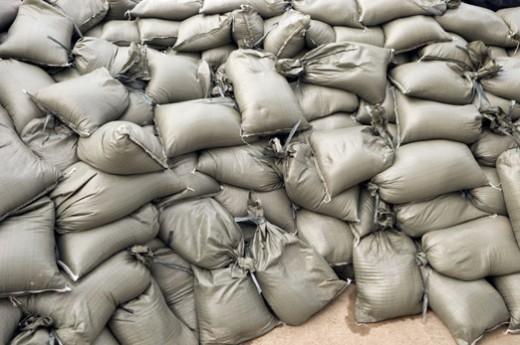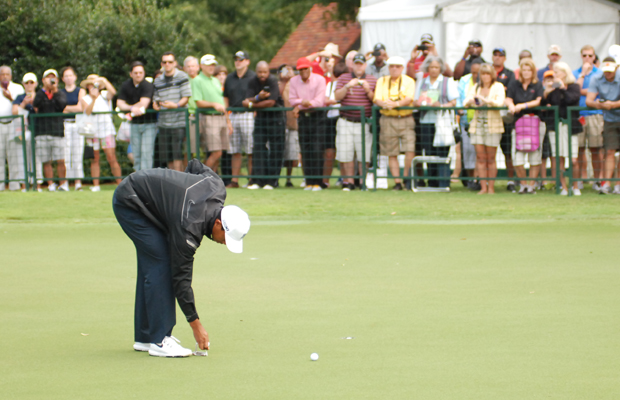Opinion & Analysis
“My handicap makes me a tremendous loser”

Congratulations to me! I am every bit as bad, and every bit as average as I thought I was! It has been a summer of having my lunch handed to me on the golf course. I wanted to believe it wasn’t all my fault. I wanted to be able to say that the way the USGA handicap system is set up, that I was destined to fail more often than not. What I found out is that failure, in my eyes and in the eyes of the USGA are two different things.
Every first and 15th day of the month, like probably millions of other golfers, I get my updated USGA handicap index emailed to me. These emails leave me shaking my head. How can I have so many rounds over par mixed in with my few great rounds a month that are under par and still end up with a handicap equating to a +3.5?
“Handicaps are there to show a golfer’s potential of shooting the course rating,” says Mary Kate Kemp, USGA Director of Handicaps and Course Rating Administrator. “It is not about your average, most people get that wrong.”
You can add me to that group of people. It seems to me that if par for a course is 72, and my stroke average for that course is 70.8, my handicap should be +1.2. I have posted 30 rounds this summer from that Tom Weiskopf gem. But I also have 30 rounds from another course that I play where the par is 71 and my stroke average is 71.9. Fair is fair, those rounds should be averaged in and my handicap must be +1.2 -0.9 for a total of +.3. I’m no math or philosophy genius but that is pure number logic right there, I don’t care who you are.
According to the USGA if a golfer posts 20 rounds in a month, the 10 highest scores are tossed and the lowest 10 are used with the slope rating of the courses to determine a player’s chances of shooting “scratch” golf. And here is yet another thing I was wrong about. Scratch golf, according to the USGA, is shooting a course’s “rating.” Par ain’t got nothing to do with it, son!
Golf courses are rated based on the length of the holes and on the number of obstacles like bunkers, ponds, trees, and everything else that is in between the tee boxes and the greens of the individual holes. The hole rated as the No. 1-handicap hole of the course may not actually be the most difficult hole on the course per se, it is more about where the people rating the course determine that the lesser skilled players would have a better chance of getting into or blocked by one of the obstacles, and or would end up having to hit an exponentially more difficult approach shot into the green based on how much more accurately a “scratch” golfer might hit a shorter club like a wedge into a green while the higher handicapper could be farther out and have as much as a five-iron in, and on that hole a stroke needs to be given to make up that difference.
Huh? Hey don’t go re-reading that previous paragraph, I’m not even sure I said it right. But how many times have we all looked at a score card and saw a hole rated a certain way and said to the guy sitting next to us in the cart with half a hot dog stuffed in his mouth, “I wonder why they have No. 1 rated as harder than No. 16?” It’s because people way smarter than us determined it should be that way.
This brings me back to me being such a tremendous loser. I look at my 20 or so rounds a month and see that I generally only shoot five or so rounds a month where I can cover the 3.5 shots I have to give back to the course to shoot the rating. So roughly 75 percent of the time my handicap is an albatross around my neck that I cannot shake. Let the self-loathing begin. There you go, breath it in.
Not so fast says Kemp and the USGA website, “You may only play to your handicap one out of five rounds or so,” she says. The USGA actually goes as far as to tell you not to be discouraged if you can only do it 20-25 percent of the time.
Where this gives me fits, and what I think is unfair, is when these handicaps are used in head-to-head matches. One such event this summer was when I was matched up against a 13 handicap in a match play affair. Before we teed off I was given our score card with 17 dots listed on the holes of the score card. It looked like a Dalmatian dog.
A quick examination of our scores posted showed that he had posted a score as low as 78 and one as high as 90 recently. My score range was a low of 64 and a high of 81. On either end of the spectrum the odds of me winning seemed quite bad.
Click here for more discussion in the “Golf Talk” forum.
I mentioned that to a fellow I know who is a strong five handicap, but prefers to carry a 10.5 for tournament purposes like these, and he bristled, “Yeah but the better player always has a better chance of not having an off day and being able to play to his handicap!”
“Really,” I said? “He shot 78 on this course last week in qualifying, if he chokes out an 85 I may still have to shoot four under to tie.” Four-under par would be one of the 25 percent of my rounds rounds the USGA bases my handicap on. For those of you keeping score at home, that means 75 percent of the time I don’t shoot that well.
Before you all berate me with deserved insults and threaten me with certain pain and misery, yes I understand that my competitor only has a 25 percent chance of shooting his handicap as well. My point was that my stroke average compared to my handicap was much more difficult to obtain than his was for him. It didn’t help that our match was over-hyped all over the club, starting with the young gun assistant pros who were taking side action.
I asked Ms. Kemp if she thought that a 13 should be able to compete with a +3.5. “Those two players are apples and oranges, really,” she said. “The skillset of a +3.5 should make it very difficult for the 13 to be competitive.
Ouch. Maybe I do stink after all. I was defeated in the match. His stroke average was about 12 shots worse than mine, but I was giving him 17 shots. There had been some talk in the earlier rounds that his handicap was notoriously “iffy,” and that when he was forced to play the tougher of the two courses at our club that those scores were always posted but not necessarily the ones from the easier course where the match was played. Either way, the difference between stroke averages would have been a more fair way to play him. I think somewhere some bright eyed mathematician needs to be able to figure out a way to weight that difference more fairly. That brings me to my next thumping.
Three years ago I played another guy in an intense head-to-head, straight-up battle that went down to the last hole. Yes, he beat me then too. But when I saw that I was going to play him this summer I was really looking forward to another great match. Then I saw the score card. He explained that he had not been posting many scores lately but that he had played in quite a few four ball tournaments and things like that. His handicap was four. So this player, who could beat me straight up on any given day, was getting seven and a half shots from me.
“You can get a handicap with as little as five posted scores,” Ms. Kemp explained, “in that instance they take your one best score and base it in the formula with the slope and the course rating.”
“There’s no question that a bigger sample of scores is more accurate though,” she added.
The course where we played has a lot of the pop holes early, and I was forced to play from behind all day and could never overcome the lead he was staked to. It was a bitter defeat. It was most bitter because I know this guy is a good player, and he’s not one to purposefully manipulate his handicap. He posted a few scores of rusty golf earlier in the spring and he posted a few as he went, but his sample was way too small to be fair.
So what about the players out there who do dishonor the whole system and keep an artificially high handicap? A great example of this was when a frequent four ball partner of mine and I played our first four ball matches as new members of a club in the annual member/member round robin tournament. We never had a chance. The joke was on us. Apparently if everyone cheats it just levels the playing field.
My partner was the same cat I mentioned before who plays to a five but now carries a 10.5. That weekend we were never close to beating anyone. There were players in the field who I had battled with for 30 years in junior golf, high school golf and college golf. These were good players. I found myself standing in the fairways with them with wedges in our hands and me giving them pops, three times in nine holes!
This brings up another aspect to the handicap system that I think is really unfair. On any given day a four handicap can beat a scratch player straight up. On any given day that four handicap player could beat a +3.5 player straight up. The chances of them both playing their best at the same time is ¼ x ¼ or 1/16. So why do they play with all of the strokes all of the time?
The difference between better players on any given day could be one more made 30-foot putt, one less wayward tee shot, one more great up and down, or anything like that. It is why over the course of four rounds Rory and Tiger generally end up beating everyone. They usually do things fractionally better than other top players, and those fractions add up.
My now former four ball partner joined the crowd and manipulated his handicap up to 10.5. I saw that he and his new partner won the member/member this summer. Hey, congratulations!
“The system is based on integrity,” Ms. Kemp adds, “but each course needs a peer review and handicap committee that can step in and police the guys that are breaking the rules.”
In a country where the number of rounds are down significantly and in an industry in decline I can’t see a club pro wanting to scare off another regular player like the guy who played in my club’s Ryder Cup matches a couple weeks ago with a less than accurate handicap. He came in with a 19 handicap and reeled off six straight pars to earn his first point for his team. Once again eyebrows were raised and feathers were ruffled, but since there was no action by a peer handicap committee, we all have ourselves to blame. By the way he reeled off those six straight pars against me and my partner in the morning four ball matches. He made par to close us out on the seventh hole of our nine-hole match. He was getting two pops on the hole.
I guess the point I am trying to make is that I don’t play well under pressure. Wait that’s not what I meant to say. What I am saying is that I wish they could make a system that was based more on averages rather than on potential. It’s interesting that they say the system is based on potential because when I tried to post a 64 this summer the machine wouldn’t let me. It spit out a message saying the score was too low! Well, maybe the machine has seen me putt.
To further prove that I don’t know what I am talking about I do have 10 or so really great head-to-head matches each summer with a buddy of mine who carries about an eight to a 10 handicap. He too posts 120 rounds or so a year. It’s uncanny how often we can play each other and have it come down to the last few holes. So maybe the system is perfect as it is.
Click here for more discussion in the “Golf talk” forum.
- LIKE0
- LEGIT0
- WOW0
- LOL0
- IDHT0
- FLOP0
- OB0
- SHANK0
19th Hole
Vincenzi’s 2024 Zurich Classic of New Orleans betting preview

The PGA TOUR heads to New Orleans to play the 2023 Zurich Classic of New Orleans. In a welcome change from the usual stroke play, the Zurich Classic is a team event. On Thursday and Saturday, the teams play best ball, and on Friday and Sunday the teams play alternate shot.
TPC Louisiana is a par 72 that measures 7,425 yards. The course features some short par 4s and plenty of water and bunkers, which makes for a lot of exciting risk/reward scenarios for competitors. Pete Dye designed the course in 2004 specifically for the Zurich Classic, although the event didn’t make its debut until 2007 because of Hurricane Katrina.
Coming off of the Masters and a signature event in consecutive weeks, the field this week is a step down, and understandably so. Many of the world’s top players will be using this time to rest after a busy stretch.
However, there are some interesting teams this season with some stars making surprise appearances in the team event. Some notable teams include Patrick Cantlay and Xander Schauffele, Rory McIlroy and Shane Lowry, Collin Morikawa and Kurt Kitayama, Will Zalatoris and Sahith Theegala as well as a few Canadian teams, Nick Taylor and Adam Hadwin and Taylor Pendrith and Corey Conners.
Past Winners at TPC Louisiana
- 2023: Riley/Hardy (-30)
- 2022: Cantlay/Schauffele (-29)
- 2021: Leishman/Smith (-20)
- 2019: Palmer/Rahm (-26)
- 2018: Horschel/Piercy (-22)
- 2017: Blixt/Smith (-27)
2024 Zurich Classic of New Orleans Picks
Tom Hoge/Maverick McNealy +2500 (DraftKings)
Tom Hoge is coming off of a solid T18 finish at the RBC Heritage and finished T13 at last year’s Zurich Classic alongside Harris English.
This season, Hoge is having one of his best years on Tour in terms of Strokes Gained: Approach. In his last 24 rounds, the only player to top him on the category is Scottie Scheffler. Hoge has been solid on Pete Dye designs, ranking 28th in the field over his past 36 rounds.
McNealy is also having a solid season. He’s finished T6 at the Waste Management Phoenix Open and T9 at the PLAYERS Championship. He recently started working with world renowned swing coach, Butch Harmon, and its seemingly paid dividends in 2024.
Keith Mitchell/Joel Dahmen +4000 (DraftKings)
Keith Mitchell is having a fantastic season, finishing in the top-20 of five of his past seven starts on Tour. Most recently, Mitchell finished T14 at the Valero Texas Open and gained a whopping 6.0 strokes off the tee. He finished 6th at last year’s Zurich Classic.
Joel Dahmen is having a resurgent year and has been dialed in with his irons. He also has a T11 finish at the PLAYERS Championship at TPC Sawgrass which is another Pete Dye track. With Mitchell’s length and Dahmen’s ability to put it close with his short irons, the Mitchell/Dahmen combination will be dangerous this week.
Taylor Moore/Matt NeSmith +6500 (DraftKings)
Taylor Moore has quickly developed into one of the more consistent players on Tour. He’s finished in the top-20 in three of his past four starts, including a very impressive showing at The Masters, finishing T20. He’s also finished T4 at this event in consecutive seasons alongside Matt NeSmith.
NeSmith isn’t having a great 2024, but has seemed to elevate his game in this format. He finished T26 at Pete Dye’s TPC Sawgrass, which gives the 30-year-old something to build off of. NeSmith is also a great putter on Bermudagrass, which could help elevate Moore’s ball striking prowess.
- LIKE6
- LEGIT1
- WOW1
- LOL0
- IDHT0
- FLOP2
- OB1
- SHANK1
19th Hole
Vincenzi’s 2024 LIV Adelaide betting preview: Cam Smith ready for big week down under

After having four of the top twelve players on the leaderboard at The Masters, LIV Golf is set for their fifth event of the season: LIV Adelaide.
For both LIV fans and golf fans in Australia, LIV Adelaide is one of the most anticipated events of the year. With 35,000 people expected to attend each day of the tournament, the Grange Golf Club will be crawling with fans who are passionate about the sport of golf. The 12th hole, better known as “the watering hole”, is sure to have the rowdiest of the fans cheering after a long day of drinking some Leishman Lager.
The Grange Golf Club is a par-72 that measures 6,946 yards. The course features minimal resistance, as golfers went extremely low last season. In 2023, Talor Gooch shot consecutive rounds of 62 on Thursday and Friday, giving himself a gigantic cushion heading into championship Sunday. Things got tight for a while, but in the end, the Oklahoma State product was able to hold off The Crushers’ Anirban Lahiri for a three-shot victory.
The Four Aces won the team competition with the Range Goats finishing second.
*All Images Courtesy of LIV Golf*
Past Winners at LIV Adelaide
- 2023: Talor Gooch (-19)
Stat Leaders Through LIV Miami
Green in Regulation
- Richard Bland
- Jon Rahm
- Paul Casey
Fairways Hit
- Abraham Ancer
- Graeme McDowell
- Henrik Stenson
Driving Distance
- Bryson DeChambeau
- Joaquin Niemann
- Dean Burmester
Putting
- Cameron Smith
- Louis Oosthuizen
- Matt Jones
2024 LIV Adelaide Picks
Cameron Smith +1400 (DraftKings)
When I pulled up the odds for LIV Adelaide, I was more than a little surprised to see multiple golfers listed ahead of Cameron Smith on the betting board. A few starts ago, Cam finished runner-up at LIV Hong Kong, which is a golf course that absolutely suits his eye. Augusta National in another course that Smith could roll out of bed and finish in the top-ten at, and he did so two weeks ago at The Masters, finishing T6.
At Augusta, he gained strokes on the field on approach, off the tee (slightly), and of course, around the green and putting. Smith able to get in the mix at a major championship despite coming into the week feeling under the weather tells me that his game is once again rounding into form.
The Grange Golf Club is another course that undoubtedly suits the Australian. Smith is obviously incredibly comfortable playing in front of the Aussie faithful and has won three Australian PGA Championship’s. The course is very short and will allow Smith to play conservative off the tee, mitigating his most glaring weakness. With birdies available all over the golf course, there’s a chance the event turns into a putting contest, and there’s no one on the planet I’d rather have in one of those than Cam Smith.

Louis Oosthuizen +2200 (DraftKings)
Louis Oosthuizen has simply been one of the best players on LIV in the 2024 seas0n. The South African has finished in the top-10 on the LIV leaderboard in three of his five starts, with his best coming in Jeddah, where he finished T2. Perhaps more impressively, Oosthuizen finished T7 at LIV Miami, which took place at Doral’s “Blue Monster”, an absolutely massive golf course. Given that Louis is on the shorter side in terms of distance off the tee, his ability to play well in Miami shows how dialed he is with the irons this season.
In addition to the LIV finishes, Oosthuizen won back-to-back starts on the DP World Tour in December at the Alfred Dunhill Championship and the Mauritus Open. He also finished runner-up at the end of February in the International Series Oman. The 41-year-old has been one of the most consistent performers of 2024, regardless of tour.
For the season, Louis ranks 4th on LIV in birdies made, T9 in fairways hit and first in putting. He ranks 32nd in driving distance, but that won’t be an issue at this short course. Last season, he finished T11 at the event, but was in decent position going into the final round but fell back after shooting 70 while the rest of the field went low. This season, Oosthuizen comes into the event in peak form, and the course should be a perfect fit for his smooth swing and hot putter this week.

- LIKE10
- LEGIT2
- WOW0
- LOL0
- IDHT0
- FLOP0
- OB0
- SHANK0
Opinion & Analysis
The Wedge Guy: What really makes a wedge work? Part 1

Of all the clubs in our bags, wedges are almost always the simplest in construction and, therefore, the easiest to analyze what might make one work differently from another if you know what to look for.
Wedges are a lot less mysterious than drivers, of course, as the major brands are working with a lot of “pixie dust” inside these modern marvels. That’s carrying over more to irons now, with so many new models featuring internal multi-material technologies, and almost all of them having a “badge” or insert in the back to allow more complex graphics while hiding the actual distribution of mass.
But when it comes to wedges, most on the market today are still single pieces of molded steel, either cast or forged into that shape. So, if you look closely at where the mass is distributed, it’s pretty clear how that wedge is going to perform.
To start, because of their wider soles, the majority of the mass of almost any wedge is along the bottom third of the clubhead. So, the best wedge shots are always those hit between the 2nd and 5th grooves so that more mass is directly behind that impact. Elite tour professionals practice incessantly to learn to do that consistently, wearing out a spot about the size of a penny right there. If impact moves higher than that, the face is dramatically thinner, so smash factor is compromised significantly, which reduces the overall distance the ball will fly.
Every one of us, tour players included, knows that maddening shot that we feel a bit high on the face and it doesn’t go anywhere, it’s not your fault.
If your wedges show a wear pattern the size of a silver dollar, and centered above the 3rd or 4th groove, you are not getting anywhere near the same performance from shot to shot. Robot testing proves impact even two to three grooves higher in the face can cause distance loss of up to 35 to 55 feet with modern ‘tour design’ wedges.
In addition, as impact moves above the center of mass, the golf club principle of gear effect causes the ball to fly higher with less spin. Think of modern drivers for a minute. The “holy grail” of driving is high launch and low spin, and the driver engineers are pulling out all stops to get the mass as low in the clubhead as possible to optimize this combination.
Where is all the mass in your wedges? Low. So, disregarding the higher lofts, wedges “want” to launch the ball high with low spin – exactly the opposite of what good wedge play requires penetrating ball flight with high spin.
While almost all major brand wedges have begun putting a tiny bit more thickness in the top portion of the clubhead, conventional and modern ‘tour design’ wedges perform pretty much like they always have. Elite players learn to hit those crisp, spinny penetrating wedge shots by spending lots of practice time learning to consistently make contact low in the face.
So, what about grooves and face texture?
Grooves on any club can only do so much, and no one has any material advantage here. The USGA tightly defines what we manufacturers can do with grooves and face texture, and modern manufacturing techniques allow all of us to push those limits ever closer. And we all do. End of story.
Then there’s the topic of bounce and grinds, the most complex and confusing part of the wedge formula. Many top brands offer a complex array of sole configurations, all of them admittedly specialized to a particular kind of lie or turf conditions, and/or a particular divot pattern.
But if you don’t play the same turf all the time, and make the same size divot on every swing, how would you ever figure this out?
The only way is to take any wedge you are considering and play it a few rounds, hitting all the shots you face and observing the results. There’s simply no other way.
So, hopefully this will inspire a lively conversation in our comments section, and I’ll chime in to answer any questions you might have.
And next week, I’ll dive into the rest of the wedge formula. Yes, shafts, grips and specifications are essential, too.
- LIKE31
- LEGIT7
- WOW1
- LOL1
- IDHT2
- FLOP3
- OB1
- SHANK3
-

 19th Hole2 weeks ago
19th Hole2 weeks agoDave Portnoy places monstrous outright bet for the 2024 Masters
-

 19th Hole2 weeks ago
19th Hole2 weeks agoTiger Woods arrives at 2024 Masters equipped with a putter that may surprise you
-

 19th Hole17 hours ago
19th Hole17 hours ago‘Absolutely crazy’ – Major champ lays into Patrick Cantlay over his decision on final hole of RBC Heritage
-

 19th Hole3 weeks ago
19th Hole3 weeks agoReport: Tiger Woods has ‘eliminated sex’ in preparation for the 2024 Masters
-

 19th Hole1 week ago
19th Hole1 week agoTwo star names reportedly blanked Jon Rahm all week at the Masters
-

 19th Hole7 days ago
19th Hole7 days agoReport: LIV Golf identifies latest star name they hope to sign to breakaway tour
-

 19th Hole1 week ago
19th Hole1 week agoNeal Shipley presser ends in awkward fashion after reporter claims Tiger handed him note on 8th fairway
-

 19th Hole6 days ago
19th Hole6 days agoBrandel Chamblee has ‘no doubt’ who started the McIlroy/LIV rumor and why






















Brunty
Jan 8, 2013 at 3:03 am
I don’t know whether your handicap system has changed now or not but in Australia we have an anchor in place. The anchor lasts for 12mths and your handicap can’t go more than 4 shots hirer. For example my lowest is 6.3, so my highest handicap can only be 10.3. The anchor resets if you get to a lower handicap or if the 12mths is up it moves to your next lowest handicap. This has stopped a few cheaters
DCGolf
Oct 4, 2012 at 10:46 pm
Play more scratch events; there are plenty of them out there and as a +4 you’re gonna win a bunch of them. Because then the ball is in ur court, there are a lot of guys playing them who are not even close to scratch.
Tim Gavrich
Oct 3, 2012 at 10:59 am
This makes a lot of sense. The better you get as a player, the closer you get in score to your potential. Just ask yourself: In general, who is more likely to shoot five shots better than his handicap, the 12 or the +3? On a par 72 golf course, the average 12 is going to break 80 more often than the average +3 is going to shoot 64.
Kevin, to play those higher-handicappers, do you move forward a set of tees or do they move back? Even though the Course Rating system should make it irrelevant, in practice it matters. I’d feel like the match was fairer if I were giving 15 shots to the 12 if her were playing all the way back with me than I would moving up to give him the 15. This is usually because a lot of golf courses, if a good player plays from shorter tees, he’s probably going to hit shorter clubs off the tee and hit his approaches from not an incredibly different spot on most holes.
Jim
Oct 3, 2012 at 9:28 am
Be happy to be a scratch, being a single digit and now going north to a 10 doesn’t feel great- the point is: its not a bad problem to have.
As a 10, I’d have to shoot a career round as someone mentioned earlier- if you feel like your buddies keep having career rounds against you- they may be sandbagging …
Boomboom
Oct 2, 2012 at 3:44 pm
Bottom line. Your handicap is your handicap. If you are honest, there is no such thing as a good or bad 5, etc. I post every score and carry a 6.5. I hate playing scratch golfers that bitch and wine during a money game about how many strokes they are giving, but they’ll brag all day in the pro shop that they are scratch.
Carter
Oct 2, 2012 at 8:13 am
Agree with Kemp, peer review a must at clubs. Recommend you consult Appendix E of Handicap Manual to determine the probability of shooting exceptional score also check out Pope of Slope web site for additional info. That said, I feel your pain, I frequently lose to players shooting “career” rounds. I particularly dislike playing off the low handicap ball. I guess like they say, if we want to win, play better.
titleistbb
Oct 1, 2012 at 8:03 pm
As a +2.2 I agree with your post. I was so tired of being pencil-whipped I only play scratch events now. Much more fun. I would suggest that. I played in my clubs premier member guest this summer with a $1,000 entry fee and got to watch an 8 shoot a natural 33 on me for 9 holes. I think this is statisticaly impossible. Daddy was on the handicap committee so not a word could be said. Funny thing was that while having lunch I saw his name on the wall as being a former club champ. Fantastic.
eagle_garrey
Oct 1, 2012 at 3:17 pm
humblebrag